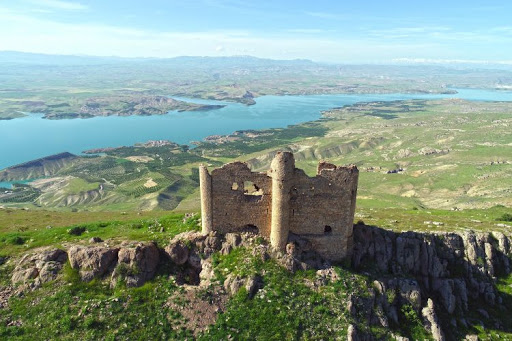Baskil is a district in the Eastern Anatolia Region of Türkiye, affiliated with the province of Elazığ. It is located approximately 38 kilometers from the city center of Elazığ. The district is accessible by both road and railway. Situated along the banks of the Euphrates River, Baskil spans a 118-kilometer shoreline around the Karakaya Dam Lake. The district is bordered by Keban to the north, the districts of Kale, Pütürge, and Battalgazi in Malatya Province to the south, Yazıhan and Arguvan to the west, the city center of Elazığ to the east, and Sivrice to the southeast. Notable mountains in the district include Piran, Hasan, Karga, Bulutlu, and Muşar. According to 2024 data from TÜİK (Turkish Statistical Institute), its population is 13,443.
History
The history of Baskil dates back to the Neolithic Age. Excavations and surface surveys in the region have revealed traces of settlement dating to the Paleolithic and Mesolithic periods. Archaeological mounds such as Caferhöyük, Değirmentepe, İmikuşağı, and Köşkerbaba have yielded artifacts from the Neolithic, Chalcolithic, Bronze, Iron Ages, as well as from the Hellenistic, Roman, Byzantine, and Ottoman periods. During the Hittite era, the area referred to as "Işuwa," which included Harput and its surroundings, also covered Baskil. The region held strategic importance during the Urartian, Roman, and Byzantine periods and came under Islamic rule in the 7th century. After the Battle of Manzikert in 1071, the area came under Turkish control and was governed by various Turkic-Islamic states such as the Çubukoğulları, Artukids, Seljuks, Dulkadirids, Akkoyunlus, and Safavids.
During the Ottoman period, the region was administratively divided into various subdistricts under the sanjaks of Harput and Malatya. In 1926, under the administrative organization of the Republic of Türkiye, it gained district status under the name Baskil. The district's name derives from the “Baskil tribe,” a subgroup of the Herdi tribe. The former village of Baskil (now called Eskibaskil) was the first settlement of the district.

Mar Ahron Monastery (Baskil Municipality)
Geography and Geomorphology
The Baskil Basin is a pull-apart depression formed around Hasan Mountain. Located on a plateau with an average elevation of 1200–1250 meters, the district features small and large streams flowing into the Euphrates River, forming alluvial plains. Kadıköy and İmikuşağı are among the prominent examples of these plains. Settlements close to the river have historically enjoyed advantages in agriculture and transportation.
Economy and Agriculture
Baskil’s economy is primarily based on agriculture. Approximately 90% of the agricultural land is used for dry farming and 10% for irrigated farming. Wheat and barley are the main crops in dry farming, while sugar beet, vegetables, and melons/watermelons are common in irrigated fields. Tomatoes, peppers, and green beans are especially widespread in riverside villages and the Baskil Plain. Although vegetables are generally grown in open fields, greenhouse cultivation is also developing. Forest and shrubland areas constitute about 6.6% of the land area.
Baskil Apricots
Baskil is one of the regions in Türkiye where the highest quality apricots are grown. The apricots cultivated in the fertile lands around the Karakaya Dam are rich in sugar and minerals. Apricot farming is conducted on 7,760 hectares of dedicated orchards. Over 70% of the production is processed as dried apricots and sold in the Malatya markets, while the rest is packaged by the Baskil Apricot Union Cooperative. The most commonly grown varieties are Hacıhaliloğlu and Kabaaşı.

Baskil Apricot (Baskil Municipality)
Livestock and Fishing
Animal husbandry in Baskil mainly involves raising sheep and goats. Sheep are primarily raised in villages of the Aydınlar subdistrict, while goats are more commonly found in mountainous villages such as Söğütdere and Konalga. Although the number of cattle is low, hybrid and culture breeds of cows are raised. Many agricultural lands were submerged due to the artificial lake formed by the Karakaya Dam, which led the local population to turn to fishing. Fishing activities are conducted through cooperatives established around the dam area.
Historical and Cultural Assets
- Tomisa Castle: Located near Geli Mezrası, this castle dates back to the Roman period and is mentioned by Strabo. The remains of the walls, made with Horasan mortar and a water cistern, are noteworthy.
- Muşar Mountain Church: Situated near Su Yatağı village, this two-story rock-built structure features a vaulted architectural style and was also likely used as a watchtower.
- Körpınar Mound: Located near Akuşağı village, this is a first-degree archaeological site where ceramics dating to the 2nd and 1st millennia BCE have been found.
- Abdulvehhab Gazi Tomb: Located in a mountainous area west of the district. According to legend, it belongs to a warrior who fought against the Byzantines and a Byzantine princess who brought him water.
Transportation and Infrastructure
Baskil has historically held strategic importance on the east-west route. Today, while road access is limited, railway transportation remains significant.
- Euphrates Railway Bridge: With a length of 2,030 meters, it is the longest railway bridge in Türkiye.
- Kömürhan Bridge: Located on the Elazığ-Malatya highway, it was completed in 1986 and is notable as the first bridge in Türkiye built using the balanced cantilever method.
Administration and Population
Established as a district in 1926, Baskil currently consists of the central subdistrict and two others named Kuşsarayı (İzolu) and Aydınlar (Muşar). There are 62 villages affiliated with the district. According to 2024 TÜİK data, the population is 13,443.


